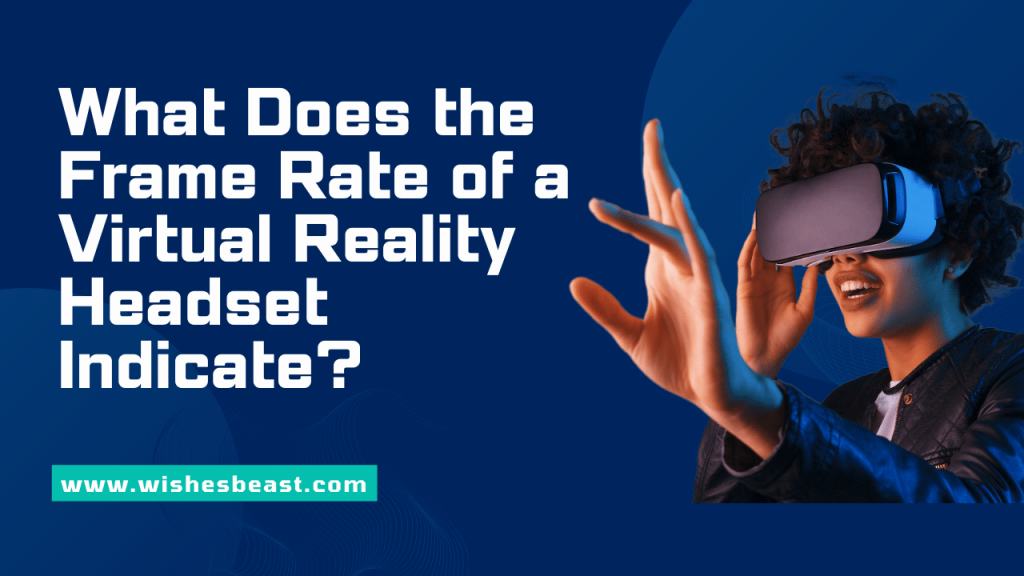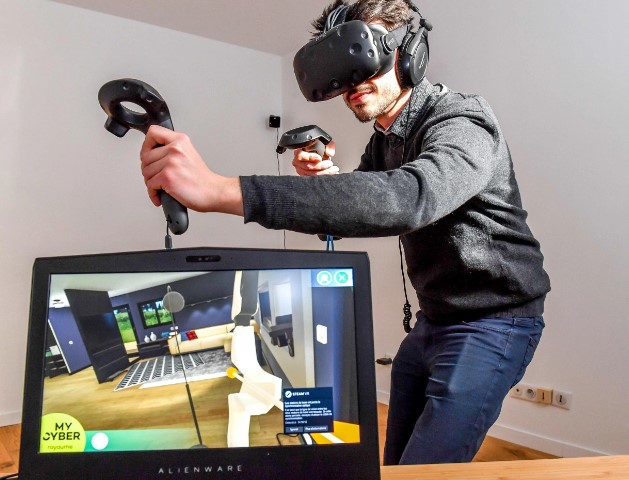What Does the Frame Rate of a Virtual Reality Headset Indicate?

As the world of virtual reality (VR) continues to evolve and enthrall users, we explore the subtle, yet crucial aspects that deliver the immersive experiences that VR promises. One such pivotal factor is the frame rate. A common term in video games and film, frame rate is the heartbeat of VR. In this comprehensive guide, we delve into the intriguing question: What does the frame rate of a virtual reality headset indicate?
Exploring: What Does the Frame Rate of a Virtual Reality Headset Indicate?

A frame rate, often measured in frames per second (FPS), refers to the number of times an image is shown on your screen each second. Higher frame rates often lead to smoother and more fluid motion, which is particularly important in VR, where realism is key. But how does this affect your VR experience?
Frame Rate and Immersion in VR
When you don the VR headset, you’re stepping into an artificial world, yet your brain expects the same sensory inputs it receives in the real world. For this world to seem authentic and immersive, the frame rate must be high enough to create a sense of continuous motion.
Renowned VR headset manufacturers, such as Oculus and HTC, provide devices with frame rates of 90 FPS or even higher. This rate ensures that the visuals are processed quickly enough to provide a smooth, life-like experience and maintain the illusion of reality.
The Impact of Frame Rate on VR Gameplay
Smooth gameplay is a must for any immersive VR experience. Stuttering graphics or lag can break the player’s immersion, turning an exciting virtual adventure into a frustrating ordeal. Higher frame rates ensure seamless and fluid gameplay, providing the player with an uninterrupted and satisfying VR journey.
Frame Rate: The Fine Balance in Virtual Reality

While higher frame rates can enhance the VR experience, achieving this isn’t without challenges. A higher frame rate requires more processing power, which might put strain on the hardware, leading to issues like overheating or shortened battery life.
Hardware Requirements for Higher Frame Rates in VR
The demand for higher frame rates means more powerful hardware is needed, especially when it comes to the graphics processing unit (GPU). GPUs need to work overtime to render the detailed environments and fast-paced action seen in many VR games and experiences.
As such, to enjoy a higher frame rate, the VR setup should include a robust GPU and a powerful processor. Consequently, achieving smoother visuals can be a costly affair, with premium VR setups requiring a considerable investment.
Frame Rate and Motion Sickness in VR
Notably, frame rate plays a critical role in mitigating VR-induced motion sickness. Some users may experience disorientation or nausea when the visuals in the headset do not align with their physical movements – a phenomenon known as VR motion sickness.
Higher frame rates can help alleviate these symptoms by reducing the lag between physical movement and virtual response. When the VR environment reacts instantaneously to the user’s actions, it significantly reduces the chances of experiencing motion sickness.
The Future of Frame Rate in Virtual Reality

As VR technology continues to advance, the demand for higher frame rates will inevitably grow. Already, we are witnessing the emergence of VR headsets that promise 120Hz or even 144Hz refresh rates, pushing the boundaries of immersive experiences to new heights.
As developers and manufacturers strive to optimize their applications and devices for these high frame rates, we can anticipate VR experiences that are more immersive, realistic, and comfortable than ever before.
The Complexities of Frame Rate Optimization in VR

While frame rate is an integral aspect of virtual reality, it doesn’t operate in isolation. It’s part of a complex system with other factors like resolution and field of view (FOV). Achieving the optimal balance between these elements is a daunting task that developers face in the quest for immersive and realistic VR experiences.
Frame Rate and Resolution: The Delicate Dance
Resolution is another critical aspect of VR. It refers to the number of pixels displayed on the screen and can dramatically affect the clarity and detail of the VR environment. However, resolution and frame rate share an intriguing relationship, akin to a balancing act.
As the resolution increases, the number of pixels that the GPU needs to render also escalates, putting extra strain on the hardware. If the hardware isn’t up to the task, the frame rate may suffer, leading to a less than optimal VR experience. Therefore, developers and users must carefully balance resolution and frame rate to create a pleasing and smooth VR experience.
Field of View and Frame Rate: The Harmony
The field of view (FOV), another vital aspect of VR, refers to the extent of the observable world that can be seen at any given moment. A wider FOV contributes to more immersive VR experiences by mimicking human peripheral vision. However, an increased FOV means more virtual environment to render, possibly impacting the frame rate.
Again, a harmony must be struck between a wider FOV and a maintainable frame rate to avoid causing discomfort or breaking the immersive experience. It’s a fine line that VR developers are continually working to tread, blending these factors to create captivating and comfortable VR experiences.
Frame Rate: A Peek into the Future

While VR has already taken giant strides, there is always room for improvement. The advancement of technology, such as foveated rendering and advanced compression algorithms, could help optimize the performance of VR systems and allow for even higher frame rates.
Foveated Rendering: A Game-Changer
Foveated rendering is a technique that mimics the human eye’s functioning, focusing on rendering higher quality visuals in the center of the screen where the user is looking, while rendering lower quality visuals in the periphery. This approach could allow for higher frame rates, as the GPU would not have to work as hard to render the entire VR environment in high detail.
The Rise of Advanced Compression Algorithms
Advanced compression algorithms could also play a significant role in pushing the frame rate limits. These algorithms work by reducing the amount of data required to display an image without drastically impacting visual quality. This could potentially ease the load on the hardware, allowing for higher frame rates even with existing hardware capabilities.
The Future is Bright and Fast
The quest for higher frame rates in VR is far from over. With relentless technological advancements, the possibility of VR experiences with even higher frame rates is becoming increasingly feasible. Such developments promise to propel VR further into mainstream acceptance, offering experiences that are not only smoother and more immersive but also more comfortable for a wider range of users.
Frequently Asked Questions On What Does the Frame Rate of a Virtual Reality Headset Indicate?
Q: How does frame rate affect the virtual reality experience?
Frame rate is fundamental to creating a smooth, immersive VR experience. It determines how fluidly the VR environment moves in response tothe user’s actions. A higher frame rate typically results in a more seamless and realistic experience.
Q: What is the ideal frame rate for a VR headset?
Currently, the industry standard for VR headsets is around 90 FPS. This frame rate ensures a smooth and immersive experience for the user, although some higher-end headsets are pushing towards 120Hz or even 144Hz.
Q: Can a higher frame rate reduce motion sickness in VR?
Yes, a higher frame rate can reduce the lag between a user’s physical movement and the VR environment’s response, which can help alleviate VR-induced motion sickness.
Q: What happens if the frame rate is too low in virtual reality?
A low frame rate can result in a less smooth VR experience, potentially causing stuttering or lag. This can break immersion and may even lead to motion sickness in some users.
Q: Are there any benefits to increasing the frame rate in virtual reality?
Increasing the frame rate in VR can lead to smoother and more lifelike visuals, enhancing immersion and reducing the risk of motion sickness. However, it requires more processing power and can therefore put a strain on the hardware.
Q: Does a higher frame rate require more powerful hardware for VR?
Yes, a higher frame rate requires more processing power, especially from the GPU. As such, achieving higher frame rates generally necessitates a more powerful (and often more expensive) VR setup.
Q: How does frame rate affect the virtual reality experience?
Frame rate is fundamental to creating a smooth, immersive VR experience. It determines how fluidly the VR environment moves in response tothe user’s actions. A higher frame rate typically results in a more seamless and realistic experience.
Q: What is the ideal frame rate for a VR headset?
Currently, the industry standard for VR headsets is around 90 FPS. This frame rate ensures a smooth and immersive experience for the user, although some higher-end headsets are pushing towards 120Hz or even 144Hz.
Q: Can a higher frame rate reduce motion sickness in VR?
Yes, a higher frame rate can reduce the lag between a user’s physical movement and the VR environment’s response, which can help alleviate VR-induced motion sickness.
Q: What happens if the frame rate is too low in virtual reality?
A low frame rate can result in a less smooth VR experience, potentially causing stuttering or lag. This can break immersion and may even lead to motion sickness in some users.
Q: Are there any benefits to increasing the frame rate in virtual reality?
Increasing the frame rate in VR can lead to smoother and more lifelike visuals, enhancing immersion and reducing the risk of motion sickness. However, it requires more processing power and can therefore put a strain on the hardware.
Q: Does a higher frame rate require more powerful hardware for VR?
Yes, a higher frame rate requires more processing power, especially from the GPU. As such, achieving higher frame rates generally necessitates a more powerful (and often more expensive) VR setup.
Also Read: Katara Camping D’Art: A Comprehensive Guide
Conclusion
In conclusion, the frame rate of a virtual reality headset not only indicates the smoothness of the experience but also provides a glimpse into the intricacies of VR development and the future of this exciting technology. So, after this guide about “What Does the Frame Rate of a Virtual Reality Headset Indicate?” next time you put on your VR headset, remember, the frames whizzing past are the unsung heroes making your extraordinary journey possible.


